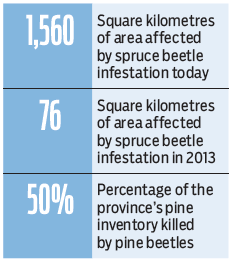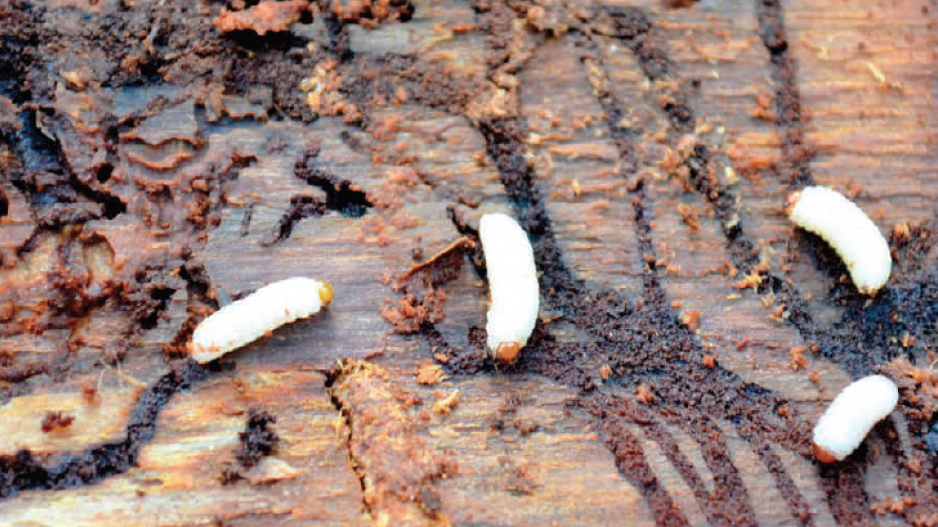An explosive outbreak of spruce beetles in northern B.C. forests is wreaking havoc on one of the key timber species remaining in the wake of the mountain pine beetle disaster.
A recent provincial survey of spruce stands in the Omineca region north of Prince George shows spruce beetle populations have mushroomed from 2013, when they covered 76 square kilometres of timber, to 1,560 square kilometres today. That 20-fold increase has set off alarm bells for both the government and the forest industry.
Climate change is one of the prime factors fuelling the outbreak of the new threat to the northern forests, said Allan Caroll, professor of entomology at the University of British Columbia’s faculty of forestry. Warmer winters mean some of the spruce beetles are completing their development over a one-year period rather than two, and drier summers are stressing the spruce trees, making them more vulnerable to attack, he said.
“We certainly have been saying for quite some time that the next big one on the radar will be the spruce beetle after the mountain pine beetle fades from the spotlight, simply because of the amount of mature spruce that’s available on the landscape,” he said.
With the pine stands decimated, the Interior forest industry is now heavily dependent upon spruce.
“We are taking it seriously,” said Archie MacDonald, general manager of forestry at the Council of Forest Industries. “The area in which the spruce beetle infestation is taking place is an area that was also hit by the mountain pine beetle. The forests in those areas are of great concern for us, not only for supplying timber for our manufacturing facilities, but also for maintaining environmental and ecological values.”
The mountain pine beetle infestation, which was also fuelled in part by climate change, killed more than 50% of the province’s pine inventory.

To combat the spruce beetle, a close relative of the mountain pine beetle, the provincial Ministry of Forests, Lands and Natural Resource Operations announced $1 million in new funding last week for an aggressive control program. Forest companies are also working together to develop management plans. To access the spruce stands, loggers are re-activating old roads and bridges that haven’t been used since the pine beetle infestation.
Heather Wiebe, manager of the province’s Omineca spruce beetle project, said the province has been monitoring the beetle for some time. The recent surge in numbers prompted the decision to combat it while it’s still just the beginning of the outbreak, she said.
Although the spruce beetle poses a threat to the forestry sector and to forest health, she said it’s not likely to cause as much widespread damage as the pine beetle. There was 10 times as much pine as there is spruce, she said, and spruce tends to grow in stands that are isolated from one another.
Pine was one contiguous forest presenting an endless buffet for the pine beetle. Further, the spruce beetle is a bulkier insect about half a centimetre long. It can’t fly as far as the pine beetle. Wiebe described the spruce beetle as a “flying tank,” capable of spreading in vast numbers to nearby trees, but not able to travel long distances.
Despite those differences, she said, the ministry still views the beetle as a serious threat.
“We are at the brink of seeing the population take off,” she said. “But there is still time for us to have a significant successful impact on the population growth.”
To combat the beetle, foresters first identify stands already killed by the beetle and then go into the surrounding stands to identify and cut down green trees that are under attack. Those logs are “hot-milled,” meaning that they are immediately transported to sawmills, killing the beetles inside the trees before they can spread.
The ministry is also cutting down spruce and leaving it defenceless on the ground, mimicking trees blown down by the wind. That attracts beetles like water to a sponge, and those logs are then removed.
To gain a better understanding of the beetle’s impact, the province intends to form a public advisory committee of First Nations, hunters and trappers, academics, local government officials and recreational users.
“The public advisory committee will really bring attention to other values at risk,” Wiebe said.
Prince George, Vanderhoof, Mackenzie and Fort St. James are the most affected communities. Forest companies operate 15 sawmills, two pulp mills and three pellet plants within the region. •




